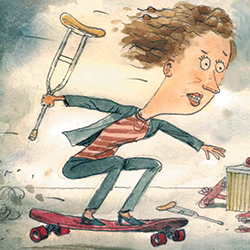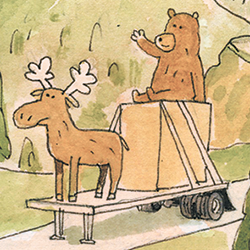As the pallets started rolling into our exhibit space, I saw, much to my horror, that the Sintra panels had warped and buckled in the heat until they looked like the wavy inside of corrugated cardboard.

As a veteran exhibit manager, I've learned to keep as many pieces of the exhibiting puzzle in my grasp as humanly possible with the help of checklists and plans and backup plans and a whole lot of people on speed dial. But even with all that planning I know that the one actually in charge is Mother Nature, and she's got a mean sense of humor.
Several years ago I was working as a contracted exhibit manager for a client at the Electronic Entertainment Expo (E3) in Los Angeles. It was a small business looking for a large-scale impact at a show where bigger is better, so it had thrown its entire marketing budget into a 5,000-square-foot double-deck exhibit. The structure had aluminum frames and Sintra panels featuring graphics on one side promoting various products, and it included overhead flying trusses. Given the complexity of the elements, setup was going to take days.
The truck bearing our exhibit had arrived at the venue at our targeted time, but the marshalling yard was chaos, and the driver sat there in the hot sunshine all day waiting for his number to be called. But this wasn't just a typical sunny southern California day; Santa Ana winds had blown in brain-boiling heat and temperatures soared toward 110 degrees by mid-afternoon. By the end of the day our driver was finally told that he would have to wait to unload until the following morning. I had built an extra day into our schedule so I wasn't fretting, but we were going to have to get busy as soon as the stuff came off the truck the next day.
I was standing in our empty exhibit space the next morning when I received an alarming call from the truck driver. He was at the loading dock watching the teamsters bring stretch-wrapped pallets off the truck and noticed that things didn't seem to be quite right with the panels. "You might want to come out here and look at this," he said. At this point we were already off schedule, and I needed to get that display up, so I told him that whatever was wrong, we would deal with it inside. Plus, it was awfully hot out there. Apparently the Sintra panels thought so, too. For as the pallets started rolling into our exhibit space, I saw, much to my horror, that they had warped and buckled in the heat until they looked like the wavy inside of corrugated cardboard. Many of our beautiful graphics were now just bizarrely distorted abstracts that would never fit inside the frames.

My first call was to the client. I didn't want to alarm my contacts there, but I felt like I should apprise them of our little situation. I also wanted to tell them to delay their arrival on site, because it was customary for company reps to come hang around the exhibit during setup, and the last thing I needed was a bunch of people under my feet watching me sweat.
The next call was to the exhibit house located in San Diego. I asked my account executive to drop whatever he was working on and get over to the venue to go through the exhibit panels with me. I had to see if anything could be saved and what he could replace in very short order.
A labor crew member helped me start the tedious task of peeling through every pallet. As we dug into the stretch-wrapped bundles, we discovered that the top one-third of every stack of panels was completely unsalvageable, the middle third had some promise of being saved, and the bottom third, thanks to the weight above it, was largely unharmed.
Next, I pulled out my exhibit graphics map, an indispensable tool that catalogs each panel with a corresponding graphic, and determined which graphics panels would need to be reproduced. When I called in the order for the ruined pieces to the exhibit house, it was ready to roll, having been placed on alert by my account executive.
When he arrived at the venue, we brainstormed ways to salvage the less-damaged panels from the center of each stack, and we hatched an idea: We'd iron out our issues. I ran back to my room to grab the hotel clothes iron, and swung by a grocery store for rolls of parchment paper. Meanwhile, the account exec raced around the hall borrowing moving pads.
We then met back at the booth, laid the pads on the floor, and spread strips of parchment paper over them. Then we placed Sintra panels with the graphics side down on top of them, and covered these with more parchment paper and moving pads. Starting out on the lowest setting and progressively turning up the heat, we ironed the slightly warped pieces to flatten out the Sintra. The trick worked for the most part, and we were able to restore many of the pieces from the middle third of the shipments to their original shape – or at least close enough to force them into their aluminum frames. Those that we couldn't save were added to our growing list of graphics that needed to be replaced. List in hand, the AE headed back down the freeway to San Diego to start production.
Next, I got a few workers back over to the booth to begin assembling the frame and the panels that were not affected by the heat, but this made the exhibit look like a giant jigsaw puzzle with a third of the pieces missing. They erected the aluminum-frame structure and slid in whatever panels they could, but piecemealing the exhibit together like that took infinitely longer than normal setup.
Meanwhile, the exhibit house put on a second shift of workers. Within 24 hours it had new panels back on a truck headed for Los Angeles, where we had cobbled together as much of the exhibit as we could.
Once we had the replacement pieces, crews worked hard to get the remainder of the exhibit built in time for the show, and when the client showed up to place its products in the exhibit, it looked like we had worked some kind of miracle. In a way we had, but I had to inform them that miracles cost money, and their budget was up $18,000 in exhibit-house rush charges and 100 hours of labor.
But the client took that bitter pill in stride, because the exhibit looked so good that many of its own booth staffers didn't notice that anything had been amiss. And besides, this was no one's fault, and there was nothing anyone could have done to prevent it. Sometimes you just need creative thinking and a solid plan B to get you through, because it's hard to beat Mother Nature. I do, however, have a trucking company with refrigerated trailers on my speed dial now.E
– Candy Adams, CTSM, CME, CEM, CMP, CMM, exhibit project manager, Defiance, OH




 As a veteran exhibit manager, I've learned to keep as many pieces of the exhibiting puzzle in my grasp as humanly possible with the help of checklists and plans and backup plans and a whole lot of people on speed dial. But even with all that planning I know that the one actually in charge is Mother Nature, and she's got a mean sense of humor.
As a veteran exhibit manager, I've learned to keep as many pieces of the exhibiting puzzle in my grasp as humanly possible with the help of checklists and plans and backup plans and a whole lot of people on speed dial. But even with all that planning I know that the one actually in charge is Mother Nature, and she's got a mean sense of humor.
 My first call was to the client. I didn't want to alarm my contacts there, but I felt like I should apprise them of our little situation. I also wanted to tell them to delay their arrival on site, because it was customary for company reps to come hang around the exhibit during setup, and the last thing I needed was a bunch of people under my feet watching me sweat.
My first call was to the client. I didn't want to alarm my contacts there, but I felt like I should apprise them of our little situation. I also wanted to tell them to delay their arrival on site, because it was customary for company reps to come hang around the exhibit during setup, and the last thing I needed was a bunch of people under my feet watching me sweat. 


